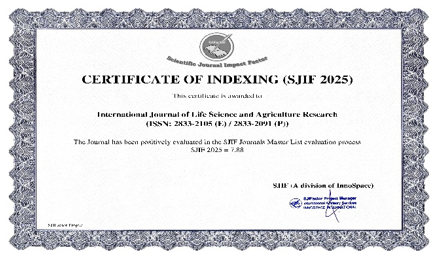Economic Impact of African Swine Fever (ASF) Disease on Pigs in Ngada Regency East Nusa Tenggara Province
DOI:
https://doi.org/10.55677/ijlsar/V03I7Y2024-03Keywords:
ASF, Pigs, Economic Loss, Head of Family.Abstract
African Swine Fever (ASF) attacks pigs with a death rate reaching 100% of the population, cannot be treated, no vaccine has been found since 2020–2023. This research data consists of primary data and secondary data. Primary data is data from interviews with farmers, livestock technical officers in 6 (six) sub-districts, quarantine officers, pig traders, and policy makers in Ngada Regency. Secondary data is ASF pig mortality data (2020, 2021, 2022, and 2023), pig population, number of pig farmers, and population data at the Central Statistics Agency (BPS). Determination of sub-districts is done by ethnicity stratified, villages/sub-districts and livestock farmer respondents (KK) carried out a simple rationing proportionally in 6 (six) sub-districts, 33 villages/sub-districts and 325 respondent families. Data are presented in the form of mean values ± standard deviation. Risk factor analysis was carried out bivariately using chi square to determine the association (relationship) between two variables followed by calculation analysis Odds Ratio (OR) to determine the strength of association between two variables. Data analysis used the SPSS version 23. The data obtained in this research is presented using pictures and tables and then described descriptively. The average results obtained by households in the three ethnic groups raising pigs were the highest for the Bajawa ethnic group at 57.2%, followed by the Soa ethnic group at 10.5%, followed by a mixture of Ngada Regency and outside Ngada Regency at 9.5%, a mixture of ethnicities in Ngada Regency as much as 9.2% and the Riung ethnic group as much as 7.1%. The economic loss of ASF disease is IDR 8,691,148,548,700 (Eight Trillion Six Hundred Ninety One Billion One Hundred Forty Eight Million Seven Hundred Rupiah) assuming that 85% of families raise pigs (Leslie et al., 2015).
References
Alamendah. (2011). Twenty-seven (27) World Heritage Site candidates from Indonesia. https://alamendah.org/2011/04/05/27-calon-situs-warisan-dunia-dari-indonesia
Barratt, A. S., Rich, K. M., Eze, J. I., Porphyre, T., Gunn, G. J., & Stott, A. W. (2019). Framework for estimating indirect costs in animal health using time series analysis. Frontiers in Veterinary Science, 6(JUN).
https://doi.org/10.3389/fvets.2019.00190
Bisimwa, P. N., Ishara, L. K., Wasso, S., Bantuzeko, F., Tonui, R., & Bwihangane, A. B. (2021). Heliyon Detection and genetic characterization of African swine fever virus ( ASFV ) in clinically infected pigs in two districts in South Kivu province , Democratic Republic Congo. 7(January), 1–8. https://doi.org/10.1016/j.heliyon.2021.e06419
BPS Propinsi NTT. (2022). Populasi Ternak Kecil Menurut Kabupaten/Kota 2020-2022. Di Dalam: 2022.
Christie, B. M. (2007). A review of animal health research opportunities in Nusa Tenggara Timur and Nusa Tenggara Barat Provinces, eastern Indonesia, Vol 65. ACIAR Technical Reports, Australian Centre for International Agricultural Research, Canberra, Australia.
Daki, A. N., Nadja, Y. R., Dhiu, D. T., Maria, G., Jo, M., Cantona, M. H., Wuri, D. A., Detha, A. I. R., Larry, R., Toha, W., & Kallau, N. H. G. (2021). Media Tropika : Jurnal Pengabdian Masyarakat. 1(1), 74–80.
Dinas Dukcapil Ngada, D. K. dan C. S. K. (2023). Visualisasi Data Kependudukan Kementerian Dalam Negeri. Visual Data. , 2022. 2023".Dukcapil.Kemendagri.Go.Id. Diakses Tanggal 24 Maret.
Disnak Ngada. (2023). Laporan Penularan Penyakit African Swine Fever (ASF) pada Ternak Babi di Kabupaten Ngada Tahun 2020. Dinas Peternakan Kabupaten Ngada.
Edwina, B., & Crompton, E. (2012). Pig movements across eastern Indonesia and associated risk of classical swine fever transmission. October.
Id, F. L., Laddomada, A., Coccollone, A., Marrocu, E., Id, T. P., Masala, G., Bandino, E., Cappai, S., & Rolesu, S. (2019). Socio-economic factors as indicators for various animal diseases in Sardinia. 1–26.
Johns, C., Cargill, C., Patrick, I., Geong, M., Ly.J., & Shearer, D. (2009). Smallholder commercial pig production in NTT - opportunities for better market integration, SADI Final Report. A. Ustralian Centre for International Agricultural Research, Canberra, Australia.
Kivumbi CC, Yona C, Hakizimana JN, M. G. (2019). An assessment of the epidemiology and socioeconomic impact of the 2019 African swine fever outbreak in Ngara district, western Tanzania. Vet Anim Sci. 2021 Aug 24;14:100198. doi: 10.1016/j.vas.2021.100198. PMID: 34585020; PMCID: PMC8455476.
Klein, L., Hessling-Zeinen, S., Adler, F., Gerdes, U., Blome, S., Beilage, E. grosse, & Campe, A. (2023). Exploring pig farmers‘ decision-making concerning biosecurity measures against African Swine Fever. Preventive Veterinary Medicine, 217(May), 105949. https://doi.org/10.1016/j.prevetmed.2023.105949
Leslie, E. E. C., Christley, R. M., Geong, M., Ward, M. P., & Toribio, J. L. M. L. (2015). Analysis of pig movements across eastern Indonesia , 2009 – 2010. Preventive Veterinary Medicine, 118(4), 293–305. https://doi.org/10.1016/j.prevetmed.2014.12.002
Martin, S.W., Meek, A.H. and Willeberg, P. (1987). Veterinary Epidemiology: Principles and Methods. Iowa State University Press, Ames, 45.
Mebus, C. . (2020). African swine fever. Adv Virus Res. 35(C):251–269. doi:10.1016/S0065-35.
Montgomery, R. E. (1921). No Title. On A Form of Swine Fever Occurring in British East Africa (Kenya Colony), Journal of Comparative Pathology and Therapeutics, 34, 159–191. https://doi.org/10.1016/S0368-1742(21)80031-4
OIE. (2019). African Swine Fever. African Swine Fever. ASF Situation. Vol.27. Paris. Https://Doi.Org/10.1016/j.Antivir Al.2019.02.018.
Penrith, M. L., Vosloo, W., Jori, F., & Bastos, A. D. S. (2013). African swine fever virus eradication in Africa. Virus Research, 173(1), 228–246. https://doi.org/10.1016/j.virusres.2012.10.011
Putt SNH, Shaw APM, Woods AJ, Tyler L, J. A. (1988). Veterinary epidemiology and economics in Africa - A manual for use in the design and appraisal of livestock health policy. 1988 Pdf_docs/PNAAW757.pdf, International Livestock Centre for Africa. http://pdf.usaid.gov/.
Zhukovskyi, M., & Nedosekov, V. (2022). Economic Analysis of Animal Diseases. In Naukovì Dopovìdì Nacìonalʹnogo Unìversitetu Bìoresursiv ì Prirodokoristuvannâ Ukraïni (Vol. 2022, Issue 6).
Downloads
Published
Issue
Section
License
Copyright (c) 2024 International Journal of Life Science and Agriculture Research

This work is licensed under a Creative Commons Attribution 4.0 International License.












